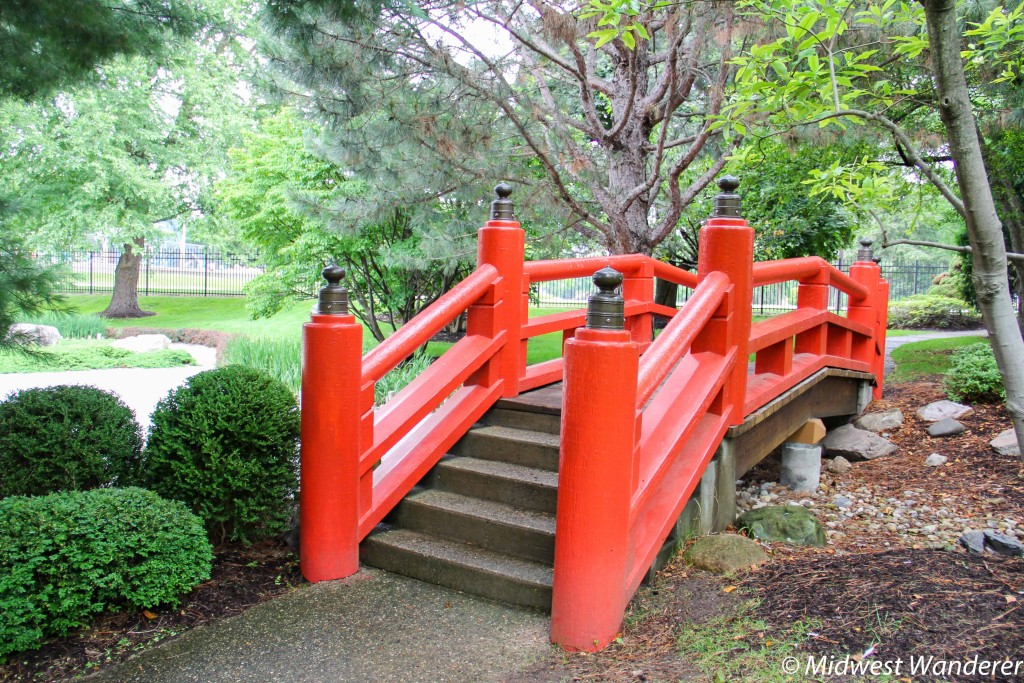Shiojiri Niwa, the Japanese garden in Mishawaka, Indiana, covers only one and a third acres of land, but the symbolism is much larger than that. The serene strolling garden is a symbol of a special bond between sister cities Mishawaka and Shiojiri City, Nagano Prefecture, Japan that began with a chance meeting in Indonesia in 1937.
 Helen Amos, a young teacher at a Mishawaka elementary school, was riding a train on Indonesia’s island of Java when she struck up a conversation with a Japanese man from Shiojiri City. When the man returned home, he told his friend, Hiro Takasuna, about his conversation with Amos. Takasuna wrote to Amos, which began a four year exchange of letters, until World War II.
Helen Amos, a young teacher at a Mishawaka elementary school, was riding a train on Indonesia’s island of Java when she struck up a conversation with a Japanese man from Shiojiri City. When the man returned home, he told his friend, Hiro Takasuna, about his conversation with Amos. Takasuna wrote to Amos, which began a four year exchange of letters, until World War II.
The war didn’t end the friendship, however. After the war the letter writing resumed, and the two began visiting each other’s communities. In 1964 Amos’ students at Battell Elementary School sent artwork and notes to students at Nishi Primary School students in Shiojiri, which began an exchange between the schools.
Don’t miss a Midwest Wanderer post. For a FREE subscription, enter your e-mail address in the Subscribe2 box to the left and click Subscribe.
In 1972 both cities made it official: they became sister cities. Over the years the cultural exchange grew to include a student exchange program and exchange visits of business people and city officials.
The Shiojiri Niwa, dedicated in August 1987 in honor of the sister-city friendship, was designed by Shoji Kanaoka, a Japanese Landscape Architect at Disney’s Epcot Center in Florida. A tranquil path winds through the garden filled with carefully shaped trees and plants. Four bridges cross a dry garden where white gravel is raked into patterns that represent ocean waves.
 Like most Japanese gardens, rocks and green plants cover most of Shiojiri Niwa, with an occasional pop of color, like a blossoming hydrangea or the red bridge, which was inspired by the bridge leading to Matsumoto Castle near Shiojiri City.
Like most Japanese gardens, rocks and green plants cover most of Shiojiri Niwa, with an occasional pop of color, like a blossoming hydrangea or the red bridge, which was inspired by the bridge leading to Matsumoto Castle near Shiojiri City.

 The teahouse pavilion in Shiojiri Niwa provides a place to rest and reflect. A traditional Japanese tea house, often found in a garden, is used for a tea ceremony.
The teahouse pavilion in Shiojiri Niwa provides a place to rest and reflect. A traditional Japanese tea house, often found in a garden, is used for a tea ceremony.
Be sure to check out our new road trip blog, U.S. Long Cuts.
 A bronze sculpture of two American and two Japanese children stands at the entrance to the garden. Designed by Hidekazu Yokozawa and dedicated in 1992, the sculpture symbolizes the start of the friendship between Shiojiri City and Mishiwaka that led to them becoming sister cities.
A bronze sculpture of two American and two Japanese children stands at the entrance to the garden. Designed by Hidekazu Yokozawa and dedicated in 1992, the sculpture symbolizes the start of the friendship between Shiojiri City and Mishiwaka that led to them becoming sister cities.
 Shiojiri Niwi, located at 1000 East Mishawaka Avenue, across from Merrifield Park, is open May 1 to October 31 from sunrise to sunset. There is no admission fee.
Shiojiri Niwi, located at 1000 East Mishawaka Avenue, across from Merrifield Park, is open May 1 to October 31 from sunrise to sunset. There is no admission fee.
Disclosure: Our visit to South Bend was hosted by Visit South Bend Mishawaka, However, any opinions expressed in this article are my own.
Thank you for reading Midwest Wanderer. Don’t miss a post. Enter your e-mail address below and click Subscribe to be notified whenever I publish another post. Subscription is FREE. After subscribing, be sure to click the link when you get the e-mail asking you to confirm. – Connie
Linked to #TheWeeklyPostcard via A Hole in My Shoe.
The Mishawaka Japanese Garden looks like such a peaceful place. Great story of how it came to be.
It’s amazing how peaceful it is even though it’s located right on a main street. You don’t notice the traffic when you’re in the garden.